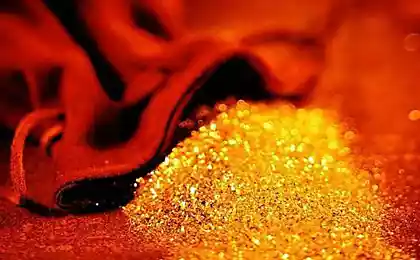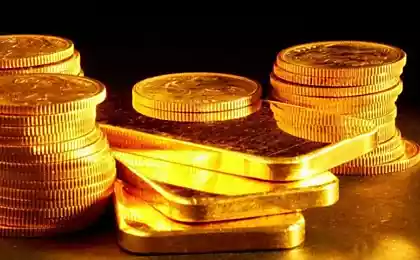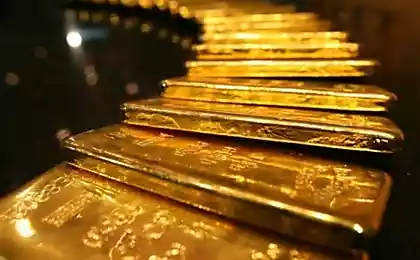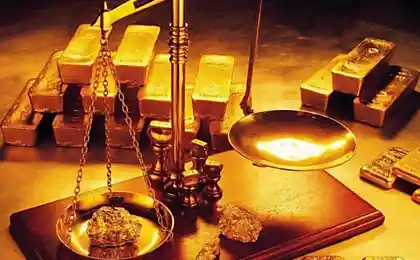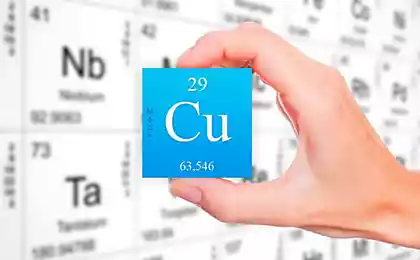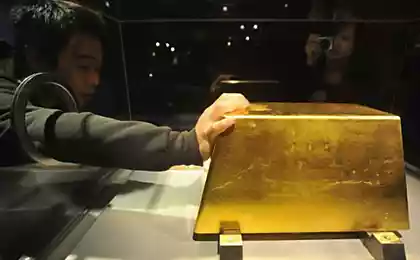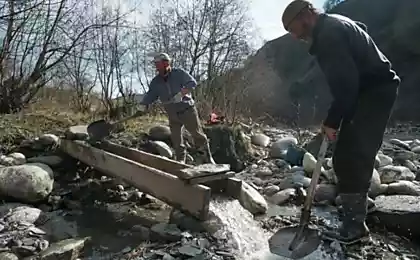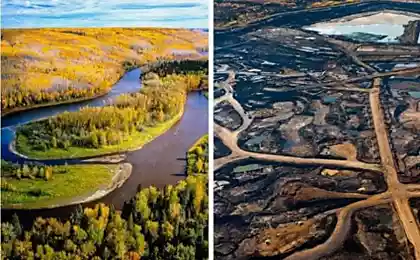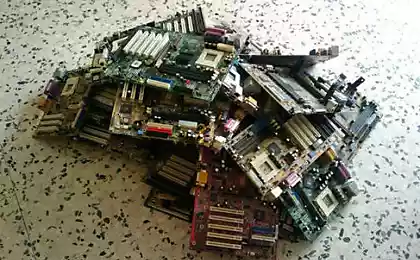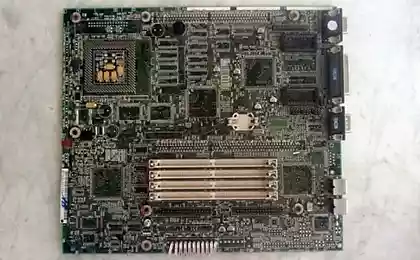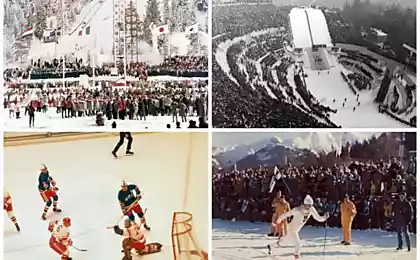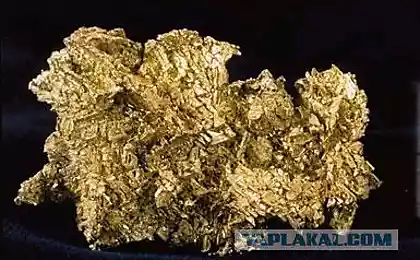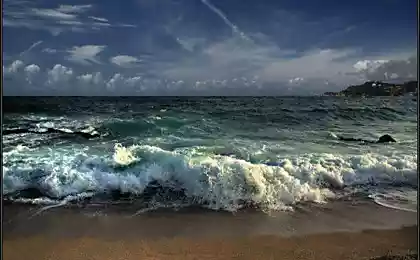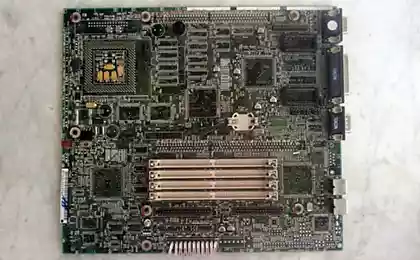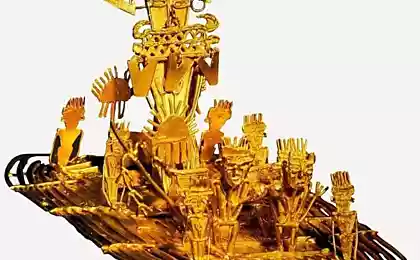756
The next gold rush is expected at a depth of 1500 meters
Rabaul, a township on the Northern tip of the island of New Britain in Papua New Guinea is still covered by the ashes of the exploded decades ago of the volcano. The eruptions already twice destroyed the city, once in 1937, the second in 1994. Both times, the inhabitants bravely met the disaster and rebuilt. Today, driving Rabaul, you will notice long sections where ash was still lying on the edge and even in some places in the middle of the road. Its layers are so thick that you will want to close the Windows so the dust filled the car.
This volcano destroyed the then main industry of the island is tourism, which after 20 years remains to be reborn – but he may become the basis for another. However, this industry does not exist yet. And some fighters for the environment, scientists and activists hope that it will not appear.
It's because here in Papua New Guinea, one rich and progressive company is going to become the first earner of minerals from great depths of the sea. This will mean that the fleet of giant robots with remote control are to produce jewelry scattered at a depth of 1 500 metres.
Look these giant underwater device come from the set of a sci-Fi movie – imagine if "Avatar" crossed with "the Abyss". They are going to dig copper, gold and other minerals there, which does not penetrate the eye.
This milestone very few people noticed, but we are approaching it very quickly. This raises questions about the future of consumption in a rapidly changing world, eager for minerals: how deep are we willing to dive to get the materials necessary for the operation of electronic devices?
The idea is to rip poorly known deep-water bottom causes a lot of unrest from local residents concerned about accidents, to scientists who worry about the ecosystem that we don't understand, but can destroy. But if such useful materials like copper, there are fewer, would it not be reasonable to produce it in the depths, away from people? Or the fact that we are going to sail the bottom of the ocean to robotic cleaning machines, may be reason enough to stop and think about our constant hunger for metal forming modern life?
One way or another, and the first deep-sea mine should start within two years in the town under the name of "Solwara-1", which was leased from the government of Papua New Guinea. It is located near the coast of Rabaul, in the water at the foot of the active volcano.

The eruption of the volcano Rabaul
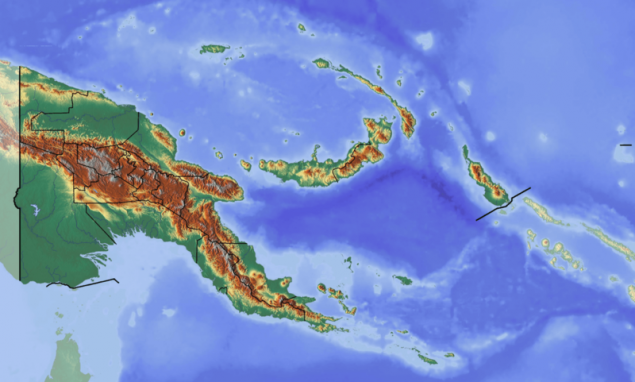
Mining on the seabed – the enterprise is as promising as nuclear fusion, and because it attracts major investments, sometimes appears in the press and on the verge of practical realization that in about fifty years. But in 2018 the canadian company Nautilus promises to begin the work that no one before her had not done a real mining at depth.
"Mining at depth will fundamentally change the international mining industry,- said the Director of the Nautilus, Mike Johnston. – On the bottom of the sea is a huge number of first-class deposits. Underwater sulphide systems like Solwara 1, there are worldwide near to hydrothermal sources, rich copper, gold, silver and zinc".
Johnstone suggests, neither more nor less, deep-sea gold rush – and not the first. First started talking about this exactly 50 years ago. The search for the development of the ocean floor began in 1965, when John Mero [John L. Mero], consultant at the shipyard and a former member of the Institute of marine resources at Berkeley, published a paper "Sea minerals". In it, he wrote that "the sea is a major storehouse of minerals that serve as the basis of industrial society", and claimed that Nickel, cobalt and copper in almost unlimited quantities lying on the ocean floor in manganese nodules (lumps that are rich in metal), waiting for the miners.
Mero offered to drop the deep-sea excavator to depths of 3 km, which would work like "a giant vacuum cleaner that collects the fine surface layer of the material."
Intrigued by this publication, the USA, France and Germany rushed to explore the depths in search of accumulations of ocean resources. Decades, these countries have sunk hundreds of millions of dollars on the ocean floor, and all in vain. A study from 2000 in the journal Science claims that this enterprise has invested $650 million, mostly to the fall in metal prices during the recession due to the oil crisis in 1973, and before scientists realized that the predictions of the Activities of the enormous wealth were overly optimistic. For decades deep-sea mining was abandoned, and the dream about the harvest of marine resources remained unrealized.
But in recent years two trends, due to which the interest in the subject returned. Increasing need for metals, particularly copper, led to a rise in profits from its production. Copper is necessary for modern life – it is malleable and conducts electricity well, so it is used in consumer electronics, cables, automobiles, refrigerators, and so on. And its cost is rapidly growing due to the vigorous industrialization of countries such as China and India. Underwater sections where it would be possible to organize production and provide other necessary in modern manufacturing minerals – Nickel, silver, gold, cobalt.
Meanwhile, new technology – such as underwater robots-miners with remote control – made the seabed more accessible. "When in 2004 I was able to familiarize with modern technologies, told me Johnstone,- it became apparent to me that there was a rapid change, and what looked simply incredible in the 1970s, is now quite simple to implement".
And the best understanding of the deep Geology has led to the emergence of a new wave of enthusiasts that have moved their interest with manganese nodules to sulphide ores formed near hydrothermal vents mid-oceanic ridges (known as "black smokers").
Nautilus is just one of the groups intending to take advantage of the trends closer to the reality of deep sea mining. This idea is actively explored in Japan and Korea, developing technologies offshore. Another private company, Neptune, has staked out several sites in the Western Pacific region.

The approach of the idea to its implementation raises some concerns. In 2007, the journal Science published an article "the dangers of deep-sea mining", which was voiced fears about the extraction of minerals from the seabed. Flows of sediment, which will cause the underwater drilling can destroy the habitat of underwater inhabitants, and this process can have a toxic effect on the entire water column. Conclusion the article reads: "plans for deep-sea mining can seriously threaten marine ecosystems". While hydrothermal vents represent the most unusual and intriguing ecosystems of all that is on Earth.
These sources are on the seabed near active volcanoes such as the volcanoes on the Atoll in the area Solwara-1, as well as the volcano on which Rabaul is located. Some scientists believe that life could arise in a place where the hot and mineral-rich sea water breaks the surface of the bottom and into the harsh and cold deep water. But geological exploration primarily interested in what these sources are constantly, albeit slowly, creates a massive near-bottom sulfide deposits.
"These sediments are deposited on the bottom, where the flow of fluid from hydrothermal vents fueled by hot magma is cooled by mixing with deep waters or by interstitial waters in sedimentary layers," explains USGS. Deposits represent a large flat lissopogonini education, lying parallel to the volcanic bedding. "Massive sulphide lenses vary greatly in size and shape and can be straccountname and sheet-like," — noted in the report.
Often they are rich in minerals like copper and gold, and find them easier than nodules from Mero. Nautilus plans to work in areas of accumulation of these materials, while not affecting the springs, to raise to the surface a large number of materials – and, of course, sell them.
"Near-bottom sulphide deposits rich in copper, and the copper content in them is higher than in the remainder of known terrestrial deposits, so in this sense they are attractive," says Cindy van Dover. Van Dover studies the seabed at Duke University and was a research consultant with Nautilus.
Van Dover was recently invited to Papua New Guinea non-profit organization TED ("ideas worth spreading"), organized a marine expedition to explore the issues of Oceanography. She was asked to give a lecture on Board the cruise ship National Geographic Orion, plied precisely the tropical water, which will soon work Nautilus.
As a trained specialist, van Dover prefers a methodical and careful approach to the problem. She speaks softly, smiles easily, her graying short hair, and during our conversations she radiated uncertainty in relation to deep sea mining. And that makes sense – thirty years of her career she has been studying deep-sea ecosystems that mining threatens to change.

"To explore hydrothermal vents I started in 1982," said she to me, while softly swaying deck was stirring my stomach. "Discovered them in 1979. So of course, when someone wants to up them to dig up and destroy?",- she adds, shaking her head. Naturally, she was worried. "Sources are active animals. We really need to know, what is the impact on these communities will have work." Life gathering around sources, often very energetic. There can meet tube worms, clams, shrimp, and deepwater fish.
From the cabin window on Orion visible to the distant pillars of smoke, the result of practice in agriculture of the region procedures burning overgrown – a constant reminder that Papua New Guinea is a poor country, which does not hurt to royalties for the extraction of minerals.
Van Dover stressed that the company Nautilus is not going suddenly to start work on the distant frontiers, and under cover of night. On the contrary, they came to her for advice, and all the way to behave proactively and transparently.
"They asked very direct questions: what do you care? she says. If we then go with this development, isn't life go back there again?". This is what excites baths Dover: ecosystems that are going to destroy. It should be noted that these habitats and the life forms living in them has already been destroyed almost on a routine basis.
"These places are destroyed by periodic volcanic eruptions, explains van Dover. For example, in the East Pacific hills, where every ten years, there have been eruptions, animals have adapted to this, and within a few months they return to their seats. A couple of years even it is impossible to say that there happened the eruption."
But in contrast to the Eastern Pacific hills, Solwara-1 animals lived longer as volcanic eruptions happen much less frequently and do not consume on a regular basis habitat. These creatures are threatened with extinction and the fault of Nautilus. Some scientists are concerned that animals will not be time to recover. Others point out that complex ecosystem have not yet fully explored – and we have no clear predictions about what would happen if there to start mining.
Nautilus claims that it will behave responsibly, and presses on the economic aspect of production. "For example, Solwara-1 in the rock contains 7% copper and 6 grams of gold per ton is 10 times more than the average ground Deposit. And copper on the bottom more than all the known deposits on land," says the Director of the Nautilus, Johnston. (On land the average content of copper in the rock less than 0.6%, and gold and 1.2 grams per ton). "One of the main parameters influencing the profitability of the mine, this level of resource, so if the seabed level is 10 times greater than on land, then it is a major advantage for underwater prey."
Further, except for the fact that land for development is located a mile beneath the surface of the water, some things in underwater development easier to do than on land. Now we're going to delve into the mining jargon.
"Massive sulphide deposits on the seabed are interested in Nautilus is located directly on the bottom surface, so that above them, there is no soil or overburden layer of soil, says van Dover. "Overburden" is the top layer of soil covering rock. That is, miners will not interfere with the extra layer of land that you need to open to get to the valuable species – they just lie on the surface.
Of course, the surface is at the bottom of the ocean, thousands of metres below sea level, this means that the company will need high-tech and complex system for the extraction of minerals. And here begins full science fiction.
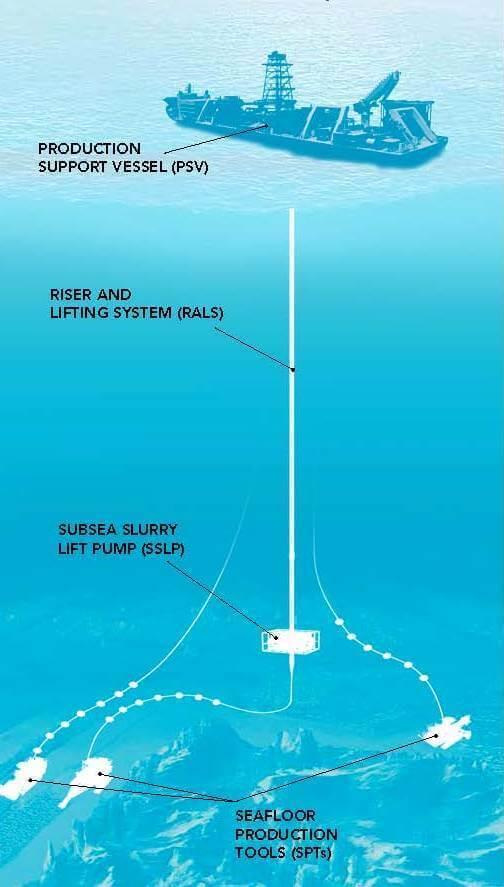
Used for the extraction of the surface vessel from which the device with the remote control fall to the bottom of the sea. Then the material is extracted, the ore is lifted out and dried. The remaining liquid, i.e. sea water, is lowered back to the bottom, says van Dover. – At the end of production at one place, the ship moves to another, so no roads, no infrastructure is required. In this regard, there is persuasive argument in favor of the fact that the mining impact on the environment is much softer than mining on land."
SUBSCRIBE to OUR youtube channel that allows you to watch online, download from YouTube free video about the recovery, the rejuvenation of man. Love for others and ourselves, as the feeling of high vibrations — an important factor for improvement .
Put LIKES and share with your FRIENDS!
www.youtube.com/channel/UCXd71u0w04qcwk32c8kY2BA/videos
Subscribe -https://www.facebook.com//
According to published drawings, the plan of the Nautilus consists of three separate robotic device, shared cooking area, extracting and storing minerals. Each device has around 15 meters long, 4-6 meters wide and weigh up to 310 tons. Three robots, manufactured by Caterpillar and SMD, cost about $100 million. Each of them will drop ship support production, which will be on the site of production such as offshore oil rigs.
First, the bottom falls "auxiliary cutter" [Auxiliary Cutter, AC], which prepares the extraction site. Will omit on plot Solwara-1 to a depth of 1500 m. With mounted on the cutting head it will cut "trench" on which will work the following robots. Second go "bulk cutter" [Bulk Cutter], larger and more powerful, but is able to work only on trenches dug with the help of AC. Then the rock will be crushed these robots on the seabed about the same as when working on land vehicles.
After removing the rocks at the place of production is sent to the machine-assembler [Machine check]. She gathers the chopped rock, pulling it in mixed with sea water by means of pumps, and pushing through a flexible tube on the hoist system to the surface. On Board mix will drain and dry the part of will be left in the tanks of the hull – it will be taken for processing other vessel.
All robots can be controlled remotely from the surface, and they are all designed to withstand the enormous pressure. But in General, as noted in the company, they represent only adaptations of existing machines used on land to clear the land before the extraction of coal or ore. Just that they will work very deep under water.
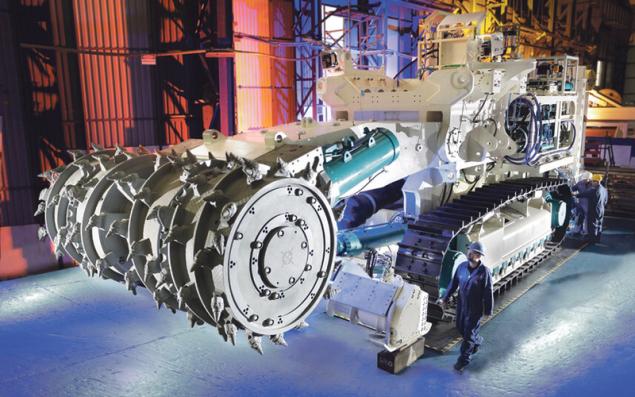
In General, this enterprise is complex, high-tech and risky. The process takes place in extreme conditions, and if any of the robots breaks down, repairing it will cost a pretty penny no doubt, sending a submersible to such depths will be difficult. And any accident threatens pollution of the environment and attract unwanted attention.
Thus, the Nautilus made him worry a large number of people.
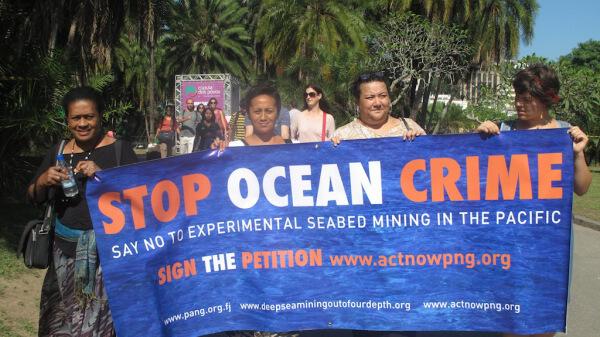
According to van Dover, Rabaul local residents have begun to protest against submarine development. Concern everything from the possible noise and light caused by the works to damage the environment. We are on the bus on the ash-covered streets, and she asked a local guide, saw the protests.
"Oh, Yes," mutters the woman, and looks out the window. Later she told me that the local "disgruntled", but the spread is not desired. She did not want to expose Rabaul in an unfavorable light. After the eruption of the tourism faded, and, apparently, foreigners are still rare on the island. Wherever we were, people were smiling at us, waving, and sometimes even welcome screaming.
Although the company Nautilus has yet to attract the world's attention to his amazing production project, it has become controversial. Local concerned with the foreign companies within their waters and the threat to the environment. Environmentalists around the world are also starting to voice their concerns on this topic. Protests against Solwara-1 have been strengthened a nascent international movement that seeks to completely stop deep-sea mining.
One of the opponents of the project – Richard Steiner, biologist and specialist on marine ecosystems, previously taught at the University of Alaska. He studied Maritime disaster with the moment at his side, unfolding the tragedy of the Exxon Valdez. I first met him many years ago: he was one of the first experts arrived at the scene of the spill BP oil in 2010, and helped to observe and analyze dissemination impact.
Today, he manages a non-profit organization, Oasis Earth, and shares knowledge with a variety of projects seeking to preserve the ecology of the planet. It supports the campaign against deep-sea mining was created to slow deep-sea mining and, in particular, one of the most notable projects in this area.
"The idea of the destruction of ecological systems on hydrothermal sources Solwara-1 is contrary to everything for which the movement fights for the conservation of marine ecosystems,- wrote to me Steiner by e-mail. – Deep sea mining will destroy the ecosystem, which scientists have not even studied, and, most likely, will lead to the extinction of species, as yet undiscovered by us".
"One thing that's crosses the ethical line, and we can't put up with it, he adds. – It will cause a serious impact with far-reaching consequences of the system of sources and all from the minerals, not really something we need (gold in particular). This project is epically bad idea."
The full impact of the project on the deep-sea ecosystem is difficult to assess. Nautilus requested nonprofit organization dedicated to environmental issues, Earth Economics, to draw up an environmental survey project Solwara, and in the review it looks pretty good. But Steiner and other critics called the report misleading, and note that it does not include a great variety of ecosystem functions and threats to marine life.
Nautilus, however, argues that their plans are not only safe, but also much safer alternatives. Land mines are at the forefront of companies that pollute the environment, mining and withdrawal of fluid can pollute rivers and soil, to create failures and maintain the forest. Pollution may adversely affect the health of people living nearby. In the case of deepwater developments, these problems are not so acute.

Auxiliary cutter
"At the bottom of the sea, obviously, lives a civilization that is not inhabited by people, says van Dover. Therefore, from the point of view of influence on society, the organization of production becomes more simple, in contrast to the development of the land".
But people who argue for the preservation of the environment, argue that copper can be extracted and not sinking into the depths. "Defenders of deep-sea mining rarely say that on land are still a lot of resources, and that there is a need to significantly increase the use of metal in the economy, to develop the concept of cradle-to-cradle ("cradle to cradle" – waste-free production systems that do not harm the environment), and design of landfills, says Steiner. – We need to stop our "economy of waste" – the extraction of minerals, use them once, and then visualware to the dump. This creates demand for increased production."
Of course, the main question is not what are some dangers of the project Solwara-1. The question is whether the implementation of the project to the emergence of a whole industry in other places which check not so carefully. "Korea and Japan are actively developing this concept, and the Neptune company already sells," says van Dover.
Lately, Korea has successfully tested a deepwater robot-miner, and Japan approved the leasing of its waters for the needs of deep-sea mining of minerals. The game connects Lockheed Martin, and Neptune is going to organize production in New Zealand. All these projects are far from completion and is unlikely to begin before 2018. The leader of the pack, the company Nautilus, will attract a lot of looks.
Constructing a giant support ship production, which will be the surface control centre, started on schedule. In October 2015 Johnston celebrated another milestone achieved, noting: "Our goal remains to develop the world's first commercial project for the extraction of rich gold and copper ore and the launch of the industry for the extraction of deep seabed resources. At that time, as the eyes of the world are awaiting the dawn of a new industry, we hope to deliver the vessel by December 2017, which will allow us to start our operations in the first quarter of 2018." To me he confirmed his statement.
"Tools for underwater mining and lifting of ore, including the pump, are either ready, or almost ready - said Johnston. Auxiliary cutter, bulk cutter and Assembly the machine is assembled and tested in factory conditions. Wet tests should begin in the first half of 2016".
Nautilus showed photos of the first three cars, and a little lit up in the press, which distributed the images impressive-looking sea Rovers. There was only one major obstacle: the construction of the vessel, which will be carried out all operations.
"The last component of a deepwater development is the ship that are critical to production. Already started cutting steel for the ship, and we are confident that it will be ready by the end of 2017". The rest of the equipment intended for use on Board, ready.
So, robotic "jaws" ready for the descent. And although the company seems to be, has taken all possible precautions, questions still remain. Even if Nautilus did all the steps to ensure correct operation, there are still many unknowns in the understanding of ecosystems that are exploited, and in establishing contacts with stakeholders. Queries Steiner to humanity on creating less waste and re-using existing materials instead of mining new may look utopian, but we came to the edge of the abyss. Few people will agitate for deep-sea mining after it started.
Driving forces, forcing miners to go into the depths of the sea, is unlikely to subside in the near future. Copper and Nickel are very popular in the market, and when millions of people join the middle class, consuming a high-tech device, their demand will only grow. And although the sea bottom looks great and is almost barren, even the scientists are not exactly sure of the consequences of mass mining around the globe. After all, gold rush is not restricted to the field Solwara-1. If Nautilus will be lucky, others would surely follow her.
"We need to clearly understand that we can lose, says van Dover. – Cumulative effects are difficult to assess. Solwara-1 – please start your prey, and see what happens. What about the next field? Where is the tipping point? How many places can you destroy? And after what speed the destruction of these ecosystems, they do not recover? I believe that the C-1 will be restored, if nothing else to touch it. But if you touch anything else when this destruction would be too much? I don't know."
Van Dover looks out the cabin window. "Is it possible to operate without disturbing the environment? Yes. Will it be this way? I'm not so optimistic". published
P. S. And remember, only by changing their consumption — together we change the world! ©
Source: geektimes.ru/post/278492/
This volcano destroyed the then main industry of the island is tourism, which after 20 years remains to be reborn – but he may become the basis for another. However, this industry does not exist yet. And some fighters for the environment, scientists and activists hope that it will not appear.
It's because here in Papua New Guinea, one rich and progressive company is going to become the first earner of minerals from great depths of the sea. This will mean that the fleet of giant robots with remote control are to produce jewelry scattered at a depth of 1 500 metres.
Look these giant underwater device come from the set of a sci-Fi movie – imagine if "Avatar" crossed with "the Abyss". They are going to dig copper, gold and other minerals there, which does not penetrate the eye.
This milestone very few people noticed, but we are approaching it very quickly. This raises questions about the future of consumption in a rapidly changing world, eager for minerals: how deep are we willing to dive to get the materials necessary for the operation of electronic devices?
The idea is to rip poorly known deep-water bottom causes a lot of unrest from local residents concerned about accidents, to scientists who worry about the ecosystem that we don't understand, but can destroy. But if such useful materials like copper, there are fewer, would it not be reasonable to produce it in the depths, away from people? Or the fact that we are going to sail the bottom of the ocean to robotic cleaning machines, may be reason enough to stop and think about our constant hunger for metal forming modern life?
One way or another, and the first deep-sea mine should start within two years in the town under the name of "Solwara-1", which was leased from the government of Papua New Guinea. It is located near the coast of Rabaul, in the water at the foot of the active volcano.

The eruption of the volcano Rabaul

Mining on the seabed – the enterprise is as promising as nuclear fusion, and because it attracts major investments, sometimes appears in the press and on the verge of practical realization that in about fifty years. But in 2018 the canadian company Nautilus promises to begin the work that no one before her had not done a real mining at depth.
"Mining at depth will fundamentally change the international mining industry,- said the Director of the Nautilus, Mike Johnston. – On the bottom of the sea is a huge number of first-class deposits. Underwater sulphide systems like Solwara 1, there are worldwide near to hydrothermal sources, rich copper, gold, silver and zinc".
Johnstone suggests, neither more nor less, deep-sea gold rush – and not the first. First started talking about this exactly 50 years ago. The search for the development of the ocean floor began in 1965, when John Mero [John L. Mero], consultant at the shipyard and a former member of the Institute of marine resources at Berkeley, published a paper "Sea minerals". In it, he wrote that "the sea is a major storehouse of minerals that serve as the basis of industrial society", and claimed that Nickel, cobalt and copper in almost unlimited quantities lying on the ocean floor in manganese nodules (lumps that are rich in metal), waiting for the miners.
Mero offered to drop the deep-sea excavator to depths of 3 km, which would work like "a giant vacuum cleaner that collects the fine surface layer of the material."
Intrigued by this publication, the USA, France and Germany rushed to explore the depths in search of accumulations of ocean resources. Decades, these countries have sunk hundreds of millions of dollars on the ocean floor, and all in vain. A study from 2000 in the journal Science claims that this enterprise has invested $650 million, mostly to the fall in metal prices during the recession due to the oil crisis in 1973, and before scientists realized that the predictions of the Activities of the enormous wealth were overly optimistic. For decades deep-sea mining was abandoned, and the dream about the harvest of marine resources remained unrealized.
But in recent years two trends, due to which the interest in the subject returned. Increasing need for metals, particularly copper, led to a rise in profits from its production. Copper is necessary for modern life – it is malleable and conducts electricity well, so it is used in consumer electronics, cables, automobiles, refrigerators, and so on. And its cost is rapidly growing due to the vigorous industrialization of countries such as China and India. Underwater sections where it would be possible to organize production and provide other necessary in modern manufacturing minerals – Nickel, silver, gold, cobalt.
Meanwhile, new technology – such as underwater robots-miners with remote control – made the seabed more accessible. "When in 2004 I was able to familiarize with modern technologies, told me Johnstone,- it became apparent to me that there was a rapid change, and what looked simply incredible in the 1970s, is now quite simple to implement".
And the best understanding of the deep Geology has led to the emergence of a new wave of enthusiasts that have moved their interest with manganese nodules to sulphide ores formed near hydrothermal vents mid-oceanic ridges (known as "black smokers").
Nautilus is just one of the groups intending to take advantage of the trends closer to the reality of deep sea mining. This idea is actively explored in Japan and Korea, developing technologies offshore. Another private company, Neptune, has staked out several sites in the Western Pacific region.

The approach of the idea to its implementation raises some concerns. In 2007, the journal Science published an article "the dangers of deep-sea mining", which was voiced fears about the extraction of minerals from the seabed. Flows of sediment, which will cause the underwater drilling can destroy the habitat of underwater inhabitants, and this process can have a toxic effect on the entire water column. Conclusion the article reads: "plans for deep-sea mining can seriously threaten marine ecosystems". While hydrothermal vents represent the most unusual and intriguing ecosystems of all that is on Earth.
These sources are on the seabed near active volcanoes such as the volcanoes on the Atoll in the area Solwara-1, as well as the volcano on which Rabaul is located. Some scientists believe that life could arise in a place where the hot and mineral-rich sea water breaks the surface of the bottom and into the harsh and cold deep water. But geological exploration primarily interested in what these sources are constantly, albeit slowly, creates a massive near-bottom sulfide deposits.
"These sediments are deposited on the bottom, where the flow of fluid from hydrothermal vents fueled by hot magma is cooled by mixing with deep waters or by interstitial waters in sedimentary layers," explains USGS. Deposits represent a large flat lissopogonini education, lying parallel to the volcanic bedding. "Massive sulphide lenses vary greatly in size and shape and can be straccountname and sheet-like," — noted in the report.
Often they are rich in minerals like copper and gold, and find them easier than nodules from Mero. Nautilus plans to work in areas of accumulation of these materials, while not affecting the springs, to raise to the surface a large number of materials – and, of course, sell them.
"Near-bottom sulphide deposits rich in copper, and the copper content in them is higher than in the remainder of known terrestrial deposits, so in this sense they are attractive," says Cindy van Dover. Van Dover studies the seabed at Duke University and was a research consultant with Nautilus.
Van Dover was recently invited to Papua New Guinea non-profit organization TED ("ideas worth spreading"), organized a marine expedition to explore the issues of Oceanography. She was asked to give a lecture on Board the cruise ship National Geographic Orion, plied precisely the tropical water, which will soon work Nautilus.
As a trained specialist, van Dover prefers a methodical and careful approach to the problem. She speaks softly, smiles easily, her graying short hair, and during our conversations she radiated uncertainty in relation to deep sea mining. And that makes sense – thirty years of her career she has been studying deep-sea ecosystems that mining threatens to change.

"To explore hydrothermal vents I started in 1982," said she to me, while softly swaying deck was stirring my stomach. "Discovered them in 1979. So of course, when someone wants to up them to dig up and destroy?",- she adds, shaking her head. Naturally, she was worried. "Sources are active animals. We really need to know, what is the impact on these communities will have work." Life gathering around sources, often very energetic. There can meet tube worms, clams, shrimp, and deepwater fish.
From the cabin window on Orion visible to the distant pillars of smoke, the result of practice in agriculture of the region procedures burning overgrown – a constant reminder that Papua New Guinea is a poor country, which does not hurt to royalties for the extraction of minerals.
Van Dover stressed that the company Nautilus is not going suddenly to start work on the distant frontiers, and under cover of night. On the contrary, they came to her for advice, and all the way to behave proactively and transparently.
"They asked very direct questions: what do you care? she says. If we then go with this development, isn't life go back there again?". This is what excites baths Dover: ecosystems that are going to destroy. It should be noted that these habitats and the life forms living in them has already been destroyed almost on a routine basis.
"These places are destroyed by periodic volcanic eruptions, explains van Dover. For example, in the East Pacific hills, where every ten years, there have been eruptions, animals have adapted to this, and within a few months they return to their seats. A couple of years even it is impossible to say that there happened the eruption."
But in contrast to the Eastern Pacific hills, Solwara-1 animals lived longer as volcanic eruptions happen much less frequently and do not consume on a regular basis habitat. These creatures are threatened with extinction and the fault of Nautilus. Some scientists are concerned that animals will not be time to recover. Others point out that complex ecosystem have not yet fully explored – and we have no clear predictions about what would happen if there to start mining.
Nautilus claims that it will behave responsibly, and presses on the economic aspect of production. "For example, Solwara-1 in the rock contains 7% copper and 6 grams of gold per ton is 10 times more than the average ground Deposit. And copper on the bottom more than all the known deposits on land," says the Director of the Nautilus, Johnston. (On land the average content of copper in the rock less than 0.6%, and gold and 1.2 grams per ton). "One of the main parameters influencing the profitability of the mine, this level of resource, so if the seabed level is 10 times greater than on land, then it is a major advantage for underwater prey."
Further, except for the fact that land for development is located a mile beneath the surface of the water, some things in underwater development easier to do than on land. Now we're going to delve into the mining jargon.
"Massive sulphide deposits on the seabed are interested in Nautilus is located directly on the bottom surface, so that above them, there is no soil or overburden layer of soil, says van Dover. "Overburden" is the top layer of soil covering rock. That is, miners will not interfere with the extra layer of land that you need to open to get to the valuable species – they just lie on the surface.
Of course, the surface is at the bottom of the ocean, thousands of metres below sea level, this means that the company will need high-tech and complex system for the extraction of minerals. And here begins full science fiction.

Used for the extraction of the surface vessel from which the device with the remote control fall to the bottom of the sea. Then the material is extracted, the ore is lifted out and dried. The remaining liquid, i.e. sea water, is lowered back to the bottom, says van Dover. – At the end of production at one place, the ship moves to another, so no roads, no infrastructure is required. In this regard, there is persuasive argument in favor of the fact that the mining impact on the environment is much softer than mining on land."
SUBSCRIBE to OUR youtube channel that allows you to watch online, download from YouTube free video about the recovery, the rejuvenation of man. Love for others and ourselves, as the feeling of high vibrations — an important factor for improvement .
Put LIKES and share with your FRIENDS!
www.youtube.com/channel/UCXd71u0w04qcwk32c8kY2BA/videos
Subscribe -https://www.facebook.com//
According to published drawings, the plan of the Nautilus consists of three separate robotic device, shared cooking area, extracting and storing minerals. Each device has around 15 meters long, 4-6 meters wide and weigh up to 310 tons. Three robots, manufactured by Caterpillar and SMD, cost about $100 million. Each of them will drop ship support production, which will be on the site of production such as offshore oil rigs.
First, the bottom falls "auxiliary cutter" [Auxiliary Cutter, AC], which prepares the extraction site. Will omit on plot Solwara-1 to a depth of 1500 m. With mounted on the cutting head it will cut "trench" on which will work the following robots. Second go "bulk cutter" [Bulk Cutter], larger and more powerful, but is able to work only on trenches dug with the help of AC. Then the rock will be crushed these robots on the seabed about the same as when working on land vehicles.
After removing the rocks at the place of production is sent to the machine-assembler [Machine check]. She gathers the chopped rock, pulling it in mixed with sea water by means of pumps, and pushing through a flexible tube on the hoist system to the surface. On Board mix will drain and dry the part of will be left in the tanks of the hull – it will be taken for processing other vessel.
All robots can be controlled remotely from the surface, and they are all designed to withstand the enormous pressure. But in General, as noted in the company, they represent only adaptations of existing machines used on land to clear the land before the extraction of coal or ore. Just that they will work very deep under water.

In General, this enterprise is complex, high-tech and risky. The process takes place in extreme conditions, and if any of the robots breaks down, repairing it will cost a pretty penny no doubt, sending a submersible to such depths will be difficult. And any accident threatens pollution of the environment and attract unwanted attention.
Thus, the Nautilus made him worry a large number of people.

According to van Dover, Rabaul local residents have begun to protest against submarine development. Concern everything from the possible noise and light caused by the works to damage the environment. We are on the bus on the ash-covered streets, and she asked a local guide, saw the protests.
"Oh, Yes," mutters the woman, and looks out the window. Later she told me that the local "disgruntled", but the spread is not desired. She did not want to expose Rabaul in an unfavorable light. After the eruption of the tourism faded, and, apparently, foreigners are still rare on the island. Wherever we were, people were smiling at us, waving, and sometimes even welcome screaming.
Although the company Nautilus has yet to attract the world's attention to his amazing production project, it has become controversial. Local concerned with the foreign companies within their waters and the threat to the environment. Environmentalists around the world are also starting to voice their concerns on this topic. Protests against Solwara-1 have been strengthened a nascent international movement that seeks to completely stop deep-sea mining.
One of the opponents of the project – Richard Steiner, biologist and specialist on marine ecosystems, previously taught at the University of Alaska. He studied Maritime disaster with the moment at his side, unfolding the tragedy of the Exxon Valdez. I first met him many years ago: he was one of the first experts arrived at the scene of the spill BP oil in 2010, and helped to observe and analyze dissemination impact.
Today, he manages a non-profit organization, Oasis Earth, and shares knowledge with a variety of projects seeking to preserve the ecology of the planet. It supports the campaign against deep-sea mining was created to slow deep-sea mining and, in particular, one of the most notable projects in this area.
"The idea of the destruction of ecological systems on hydrothermal sources Solwara-1 is contrary to everything for which the movement fights for the conservation of marine ecosystems,- wrote to me Steiner by e-mail. – Deep sea mining will destroy the ecosystem, which scientists have not even studied, and, most likely, will lead to the extinction of species, as yet undiscovered by us".
"One thing that's crosses the ethical line, and we can't put up with it, he adds. – It will cause a serious impact with far-reaching consequences of the system of sources and all from the minerals, not really something we need (gold in particular). This project is epically bad idea."
The full impact of the project on the deep-sea ecosystem is difficult to assess. Nautilus requested nonprofit organization dedicated to environmental issues, Earth Economics, to draw up an environmental survey project Solwara, and in the review it looks pretty good. But Steiner and other critics called the report misleading, and note that it does not include a great variety of ecosystem functions and threats to marine life.
Nautilus, however, argues that their plans are not only safe, but also much safer alternatives. Land mines are at the forefront of companies that pollute the environment, mining and withdrawal of fluid can pollute rivers and soil, to create failures and maintain the forest. Pollution may adversely affect the health of people living nearby. In the case of deepwater developments, these problems are not so acute.

Auxiliary cutter
"At the bottom of the sea, obviously, lives a civilization that is not inhabited by people, says van Dover. Therefore, from the point of view of influence on society, the organization of production becomes more simple, in contrast to the development of the land".
But people who argue for the preservation of the environment, argue that copper can be extracted and not sinking into the depths. "Defenders of deep-sea mining rarely say that on land are still a lot of resources, and that there is a need to significantly increase the use of metal in the economy, to develop the concept of cradle-to-cradle ("cradle to cradle" – waste-free production systems that do not harm the environment), and design of landfills, says Steiner. – We need to stop our "economy of waste" – the extraction of minerals, use them once, and then visualware to the dump. This creates demand for increased production."
Of course, the main question is not what are some dangers of the project Solwara-1. The question is whether the implementation of the project to the emergence of a whole industry in other places which check not so carefully. "Korea and Japan are actively developing this concept, and the Neptune company already sells," says van Dover.
Lately, Korea has successfully tested a deepwater robot-miner, and Japan approved the leasing of its waters for the needs of deep-sea mining of minerals. The game connects Lockheed Martin, and Neptune is going to organize production in New Zealand. All these projects are far from completion and is unlikely to begin before 2018. The leader of the pack, the company Nautilus, will attract a lot of looks.
Constructing a giant support ship production, which will be the surface control centre, started on schedule. In October 2015 Johnston celebrated another milestone achieved, noting: "Our goal remains to develop the world's first commercial project for the extraction of rich gold and copper ore and the launch of the industry for the extraction of deep seabed resources. At that time, as the eyes of the world are awaiting the dawn of a new industry, we hope to deliver the vessel by December 2017, which will allow us to start our operations in the first quarter of 2018." To me he confirmed his statement.
"Tools for underwater mining and lifting of ore, including the pump, are either ready, or almost ready - said Johnston. Auxiliary cutter, bulk cutter and Assembly the machine is assembled and tested in factory conditions. Wet tests should begin in the first half of 2016".
Nautilus showed photos of the first three cars, and a little lit up in the press, which distributed the images impressive-looking sea Rovers. There was only one major obstacle: the construction of the vessel, which will be carried out all operations.
"The last component of a deepwater development is the ship that are critical to production. Already started cutting steel for the ship, and we are confident that it will be ready by the end of 2017". The rest of the equipment intended for use on Board, ready.
So, robotic "jaws" ready for the descent. And although the company seems to be, has taken all possible precautions, questions still remain. Even if Nautilus did all the steps to ensure correct operation, there are still many unknowns in the understanding of ecosystems that are exploited, and in establishing contacts with stakeholders. Queries Steiner to humanity on creating less waste and re-using existing materials instead of mining new may look utopian, but we came to the edge of the abyss. Few people will agitate for deep-sea mining after it started.
Driving forces, forcing miners to go into the depths of the sea, is unlikely to subside in the near future. Copper and Nickel are very popular in the market, and when millions of people join the middle class, consuming a high-tech device, their demand will only grow. And although the sea bottom looks great and is almost barren, even the scientists are not exactly sure of the consequences of mass mining around the globe. After all, gold rush is not restricted to the field Solwara-1. If Nautilus will be lucky, others would surely follow her.
"We need to clearly understand that we can lose, says van Dover. – Cumulative effects are difficult to assess. Solwara-1 – please start your prey, and see what happens. What about the next field? Where is the tipping point? How many places can you destroy? And after what speed the destruction of these ecosystems, they do not recover? I believe that the C-1 will be restored, if nothing else to touch it. But if you touch anything else when this destruction would be too much? I don't know."
Van Dover looks out the cabin window. "Is it possible to operate without disturbing the environment? Yes. Will it be this way? I'm not so optimistic". published
P. S. And remember, only by changing their consumption — together we change the world! ©
Source: geektimes.ru/post/278492/
